Search
- Page Path
-
- HOME
- Search
- Review Article
- Infection
- Community-acquired pneumonia in children: updated perspectives on its etiology, diagnosis, and treatment
- Ki Wook Yun
- Clin Exp Pediatr. 2024;67(2):80-89. Published online June 14, 2023
-
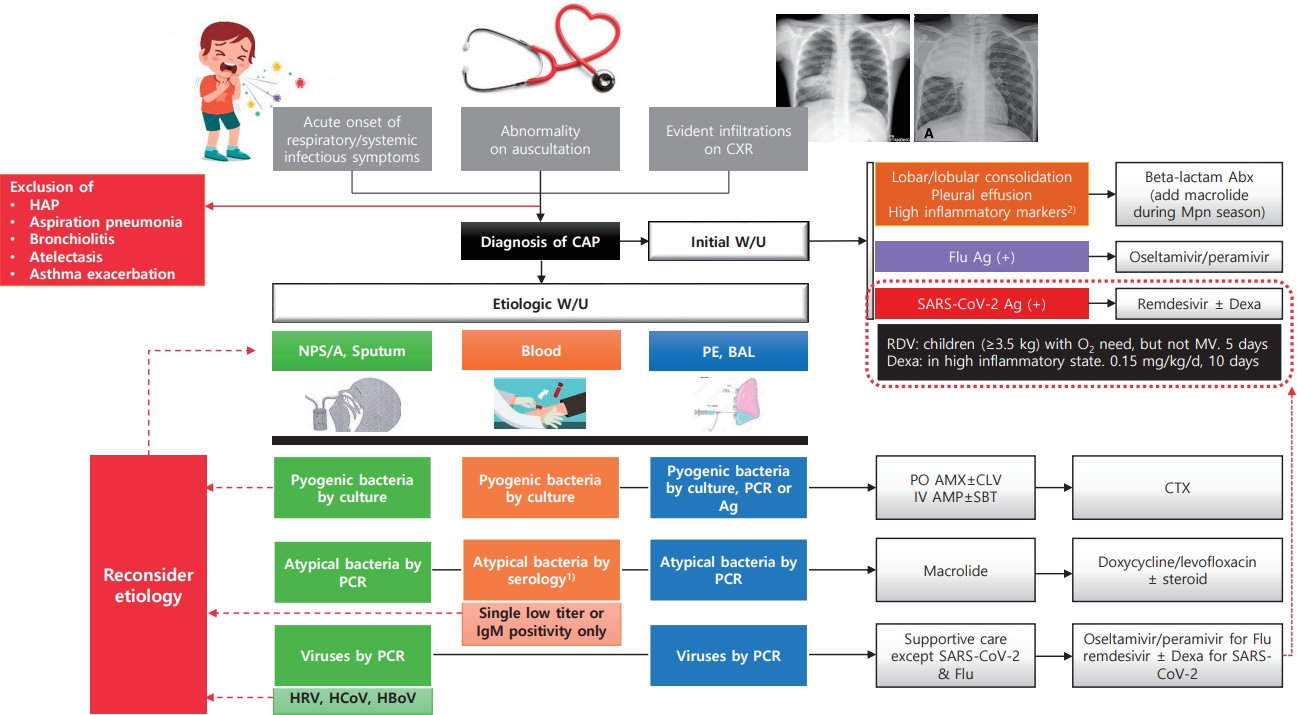
· Most commonly confirmed causes of community-acquired pneumonia (CAP) in children are Mycoplasma pneumoniae (8%–40%) and respiratory syncytial virus (15%–20%).
· Pyogenic bacteria, most commonly Streptococcus pneumoniae (40%–50%) and Streptococcus pyogenes (10%–25%), are detected in 2%–5% of children hospitalized with CAP.
· CAP should be diagnosed conservatively according to clinical and radiological criteria.
· The etiology should be identified via appropriate test result interpretation.
- Allergy
- Moderate to severe atopic dermatitis in children: focus on systemic Th2 cytokine receptor antagonists and Janus kinase inhibitors
- Jeong Hee Kim, Mona Salem Samra
- Clin Exp Pediatr. 2024;67(2):64-79. Published online June 14, 2023
-
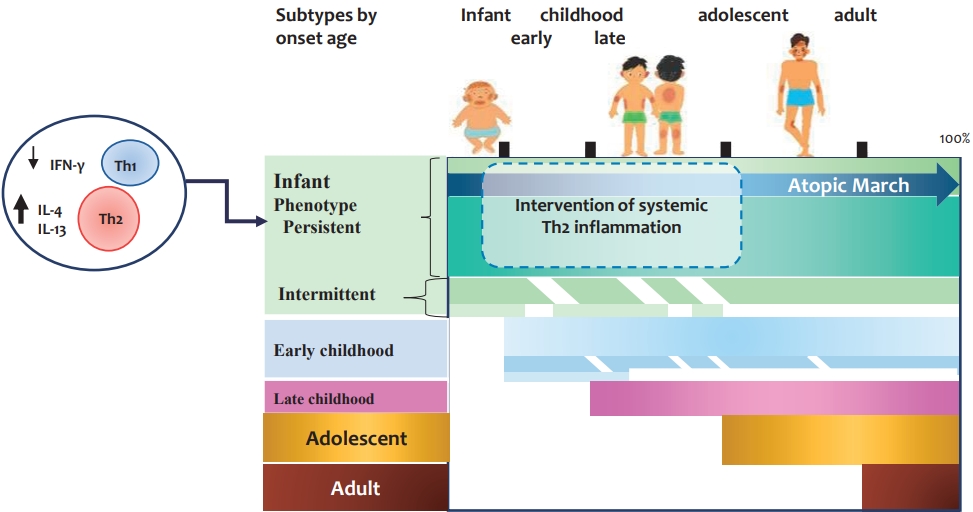
· Atopic dermatitis (AD) is characterized by a strong T helper (Th)2 response, although the extents of Th22, Th17/ interleukin (IL)-23, and Th1 responses vary among disease subtypes.
· Children with moderate to severe AD may require early systemic therapy to reduce the systemic inflammation caused by increased Th2 cytokine levels.
· Dupilumab, which blocks IL-4/IL-13 receptor, has equivalent efficacy for extrinsic and intrinsic AD and a favorable safety profile in infants and children aged 6 months and older.
- Cardiology
- Research trends on causes of Kawasaki disease in the COVID-19 era: focus on viral infections
- Young Hwan Lee
- Clin Exp Pediatr. 2023;66(1):1-11. Published online June 22, 2022
-
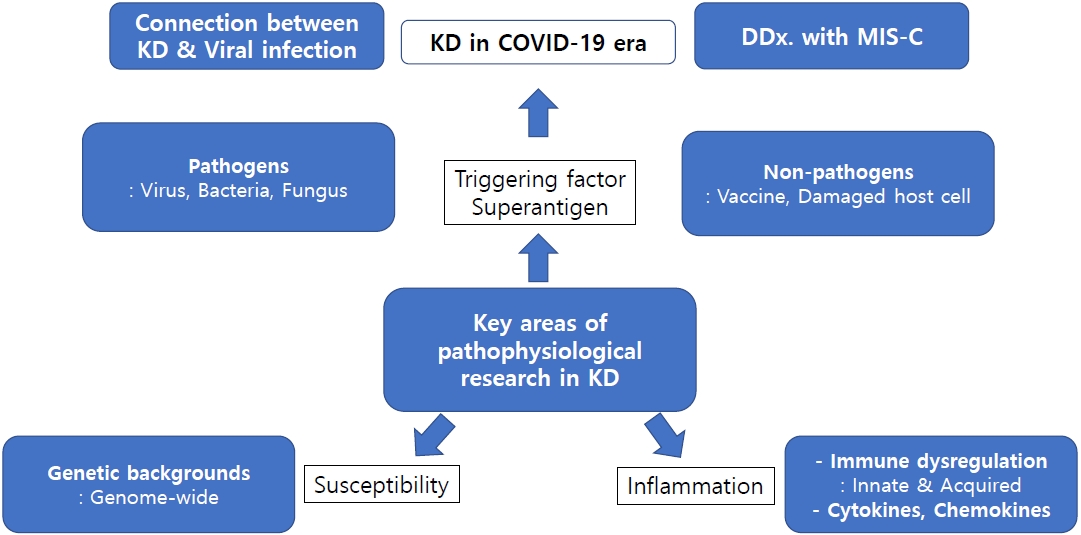
· The etiology of Kawasaki disease (KD) is unclear, but its clinical, epidemiological, and pathophysiological characteristics are strongly associated with infectious diseases.
· In the coronavirus disease 2019 pandemic era, viruses are attracting the most attention. Sudden acute respiratory syndrome coronavirus 2 infection causes various hyperinflammation in children that require differentiation from KD.
· Immune responses in patients with KD may be induced by host cell damage. To effectively prevent and treat KD, the genetic background and immune responses of KD patients and triggering pathogens require identification.
- Neurology
- Neonatal seizures: diagnostic updates based on new definition and classification
- Eun-Hee Kim, Jeongmin Shin, Byoung Kook Lee
- Clin Exp Pediatr. 2022;65(8):387-397. Published online April 4, 2022
-
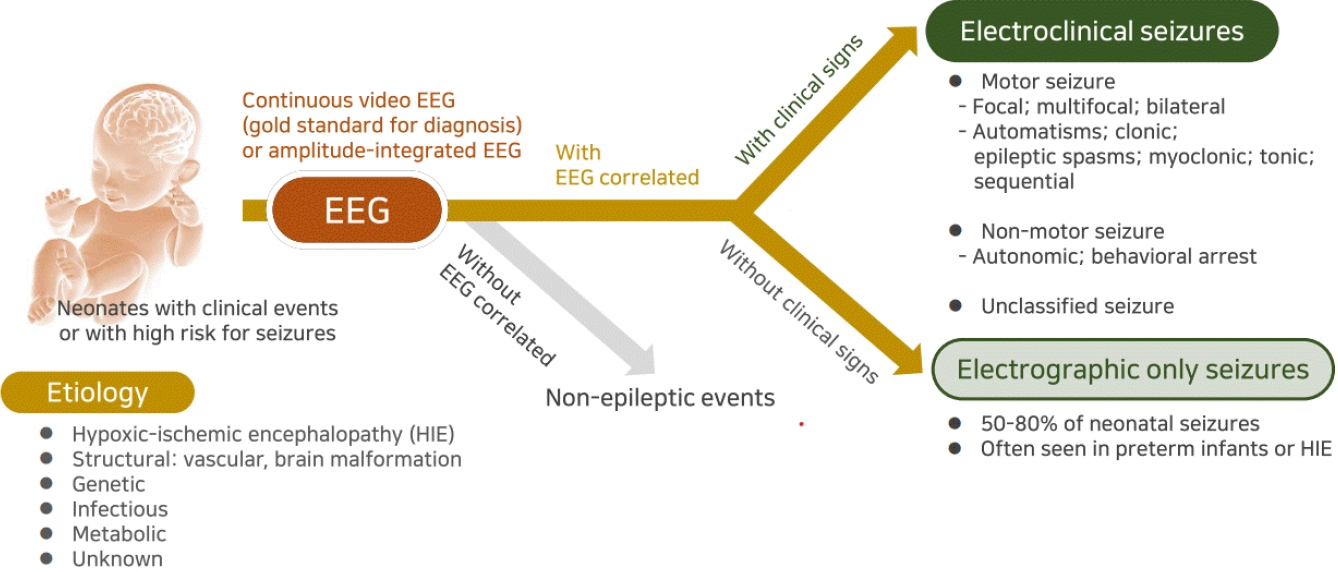
· Neonatal seizures are often electrographic-only seizures without clinical signs; therefore, the identification of electrical seizure activity on electroencephalography is the gold standard for diagnosis.
· Clinical signs of neonatal seizures are divided into motor or nonmotor seizures, and motor seizures are mostly focal or multifocal.
· Most neonatal seizures are caused by acute symptomatic etiologies, but in cases of intractable seizures, structural, genetic, or metabolic etiologies should be investigated.
- Original Article
- Infection
- Febrile urinary tract infection in children: changes in epidemiology, etiology, and antibiotic resistance patterns over a decade
- Woosuck Suh, Bi Na Kim, Hyun Mi Kang, Eun Ae Yang, Jung-Woo Rhim, Kyung-Yil Lee
- Clin Exp Pediatr. 2021;64(6):293-300. Published online October 14, 2020
-
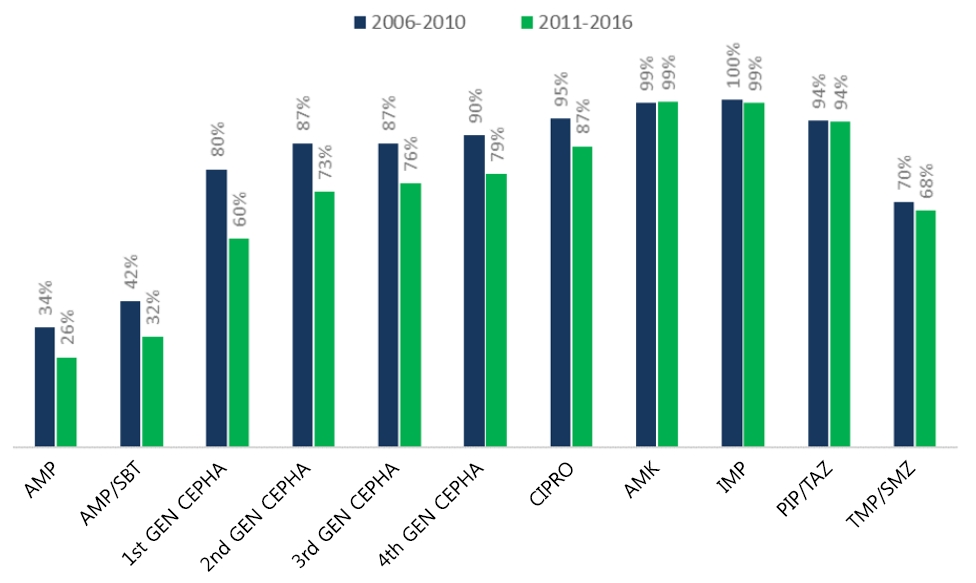
Question: How has the antibiotic susceptibility of urinary pathogens changed and what does it imply?
Finding: A yearly increase in multidrug-resistant and extended-spectrum β-lactamase (ESBL)–producing pathogens was observed. A higher recurrence rate was observed in cases of febrile urinary tract infection caused by ESBL producers in patients with underlying vesicoureteral reflux (VUR).
Meaning: The initial empirical antibiotic should reflect the changing susceptibility patterns and underlying VUR status.
- Review Article
- Approaches to the diagnosis and management of chronic urticaria in children
- Sun Hee Choi, Hey Sung Baek
- Clin Exp Pediatr. 2015;58(5):159-164. Published online May 22, 2015
-
Most guidelines for chronic urticaria (CU) in infants and children are based on limited pediatric evidence. Current evidence used to guide treatment in children is extrapolated from data focusing on older age groups. CU in children is a different and complex condition than that in adults. Furthermore, there is little published information regarding urticaria in Korean children. The aim of...
- Original Article
- Apoptosis and upregulation of TNF-α and TRAIL receptor 1 (DR4) in the pathogenesis of food protein-induced enterocolitis syndrome
- Jin-Bok Hwang, Sang Pyo Kim, Yu Na Kang, Seong-Ryong Lee, Seong-Il Suh, Taeg Kyu Kwon
- Clin Exp Pediatr. 2010;53(4):525-531. Published online April 15, 2010
-
Purpose : Expression levels of tumor necrosis factor (TNF)-α expression on the mucosa of the small intestine is increased in patients with villous atrophy in food protein-induced enterocolitis syndrome (FPIES). TNF-α has been reported to induce apoptotic cell death in the epithelial cells. We studied the TNF family and TNF-receptor family apoptosis on the duodenal mucosa to investigate their roles in the pathogenesis... -
- Complex febrile convulsions: A clinical study
- Jeong Sic Kang, Sa-Ra Kim, Dong Wook Kim, Tae Won Song, Nam Hee Kim, Jong Hee Hwang, Jin Soo Moon, Chong Guk Lee
- Clin Exp Pediatr. 2009;52(1):81-86. Published online January 15, 2009
-
Purpose : Febrile convulsions are classified into simple or complex types, the latter being characterized by increased risk of recurrence and progression to epilepsy. This study aimed to delineate the clinical characteristics of complex febrile convulsions. Methods : Between January 2003 and December 2006, 550 children were diagnosed with febrile convulsions at the Department of Pediatrics, Ilsan Paik Hospital. Their... -
- A clinical study on the etiology of parapneumonic effusion in children
- Jung-Sook Yeom, Won-Tae Bae, Eun-Sil Park, Ji-Hyun Seo, Jae-Young Lim, Chan-Hoo Park, Hyang-Ok Woo, Hee-Shang Youn
- Clin Exp Pediatr. 2006;49(1):56-63. Published online January 15, 2006
-
Purpose : This study was designed to document the etiologies and the characteristics of parapneumonic effusion in children. Methods : During a 17-year period from 1987 to 2004, parapneumonic effusion was confirmed in 86 children at Gyeongsang National University Hospital. The clinical records of these children were reviewed and radiological findings and laboratory data, especially results of thoracentesis, were analyzed retrospectively. Results... -
- The Efficacy of Speech and Language Therapy for Children with Speech and Language Delays according to the Eiologies
- June-Bum Kim, Jin-Soon Suh, Young-Hoon Kim, Seung-Yun Chung, In-Goo Lee, Kyung-Tai Whang, Byung-Churl Lee
- Clin Exp Pediatr. 2005;48(9):924-928. Published online September 15, 2005
-
Purpose : Treatment efficacy for children with speech and language delay has been the subject of considerable debate in recent years. We evaluated the clinical features of children with delayed speech and language and their prognoses according to their etiologies after 6 months of speech and language therapy. Methods : From January, 2000 to March, 2004, we retrospectively reviewed 56... -
- Etiology of Community-acquired Bacteremia in Healthy Children
- Hyung Tae Kim, Hyun Oh Jang, Jin Soo Moon, Seung Yeon Nam, Dong Wook Kim, Chong Guk Lee, Chong Rae Cho
- Clin Exp Pediatr. 2005;48(7):716-722. Published online July 15, 2005
-
Purpose : A full view of the spectrum of all bacterial diseases in healthy children is essential to the establishment of public health priorities. Accurate information on the relative importance of the various pathogens in terms of the age of the affected patients, the site of infection and the case fatality rate are valuable to the clinician in choosing antimicrobial... -
- A Clinical Study on the Etiologies of Acute Seizures in Children Who Visited Emergency Department
- Jung Il Cho, Dong Wook Kim, Hyun Oh Jang, Jin Soo Moon, Seung Yeon Nam, Seung Yeon Nam
- Clin Exp Pediatr. 2004;47(12):1312-1318. Published online December 15, 2004
-
Purpose : Although it is important to know the etiologies of childhood seizures according to age, clinical studies on this topic have been few. The present study was therefore designed to investigate the causes of acute childhood seizures. We hope this study will be helpful in the diagnosis and management of children with seizures. Methods : This study was retrospectively undertaken... -
- Etiologic Agents and Clinical Features of Acute Pyogenic Osteoarthritis in Children
- Young Ho Kwak, Su Eun Park, Jung Youn Hong, He Sun Jung, Jin Young Park, Jung Hwan Choi, Hoan Jong Lee, In Ho Choi
- Clin Exp Pediatr. 2000;43(4):506-513. Published online April 15, 2000
-
Purpose : Though acute pyogenic infections of musculoskeletal system are infrequent in children, delayed diagnosis or inadequate management may cause serious chronic sequelae. We analysed 40 cases of children who were affected by acute septic osteomyelitis and/or septic arthritis to find etiologic agents and to establish proper initial antimicrobial therapy. Methods : Medical records of 40 cases of microbiologically confirmed acute... -
- Clinicial Observations of Oliguric Acute Renal Failure in Children
- Sung-Soo Lee, Young-Mi Choi, Chong-Woo Bae, Sung-Ho Cha, Byoung-Soo Cho
- Clin Exp Pediatr. 1999;42(10):1419-1425. Published online October 15, 1999
-
Purposes : We studied the clinicial findings of oliguric acute renal failure(ARF) developed on admission or during treatment of other diseases. Methods : We performed a retrospective analysis of medical records of 118 patients with oliguric ARF who had been admitted to Kyunghee University Hospital since January 1988 to December 1997. Diagnostic criteria of oliguric ARF are serum creatinine>1.0mg/dl and urine... -
- A Clinical Study on the Etiology and the Characteristics of Pleural Effusion in Children
- Jin Hwa Jeong, Song Yi Rah, Yong Han Sun, Myung Hyun Lee, Young Yull Koh
- Clin Exp Pediatr. 1998;41(1):62-73. Published online January 15, 1998
-
Purpose : Many different conditions result in pleural effusions(PEs) and making the differential diagnosis of PE is difficult. The purpose of the present study was to document the change of incidence and compare the etiologies of PEs with regards to age, the sidedness and characteristics of PE. Methods : During the 10-year period from 1986 to 1995, thoracentesis was performed in 197 children with PEs... -
- Etiological Classification of Mentally Retarded Children Enrolled in a Special Educational Institution
- Seon-Kyeong Yoo, Han-Wook Yoo
- Clin Exp Pediatr. 1994;37(10):1437-1448. Published online October 15, 1994
-
Mental retardation(MR) is classically deficits in adaptive behavior and manifest during the developmental period. The causes of mental retardation were not understood in many cases. This study was undertaken to identify the etiologies of mentally retarded children enrolled in a special educational institution under the hypothesis that clarifying causes of MR can not only provide basic epidemiological data on MR in... -
-

-
-

-

-
Impact Factor4.2
-
6.52022CiteScore92nd percentilePowered by







